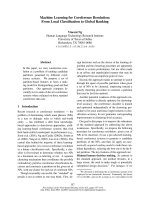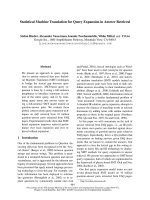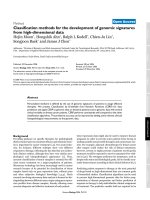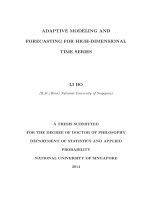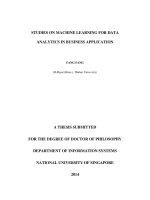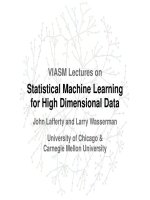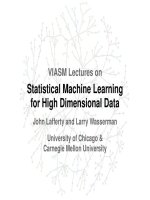Statistical Machine Learning for High Dimensional Data
Bạn đang xem bản rút gọn của tài liệu. Xem và tải ngay bản đầy đủ của tài liệu tại đây (1.52 MB, 68 trang )
VIASM Lectures on
Statistical Machine Learning
for High Dimensional Data
John Lafferty and Larry Wasserman
University of Chicago &
Carnegie Mellon University
References
• Statistical Machine Learning. Lafferty, Liu and Wasserman
(2012).
• The Elements of Statistical Learning. Hastie, Tibshirani and
Friedman (2009).
(www-stat.stanford.edu/˜tibs/ElemStatLearn/)
• Pattern Recognition and Machine Learning Bishop (2009).
2
Outline
1
Regression
predicting Y from X
2
Structure and Sparsity
finding and using hidden structure
3
Nonparametric Methods
using statistical models with weak assumptions
4
Latent Variable Models
making use of hidden variables
3
Introduction
• Machine learning is statistics with a focus on prediction,
scalability and high dimensional problems.
• Regression: predict Y ∈ R from X .
• Classification: predict Y ∈ {0, 1} from X .
Example: Predict if an email X is real Y = 1 or spam Y = 0.
• Finding structure. Examples:
Clustering: find groups.
Graphical Models: find conditional independence structure.
4
Three Main Themes
Convexity
Convex problems can be solved quickly. If necessary,
approximate the problem with a convex problem.
Sparsity
Many interesting problems are high dimensional. But often, the
relevant information is effectively low dimensional.
Nonparametricity
Make the weakest possible assumptions.
5
Preview: Graphs on Equities Data
Preview: Finding relations between stocks in the S&P 500:
● ● ●
●
●
●
●
●
●
●
●
●
●
● ●
●
● ●
● ●
●
●
●
●
●
●
●
●
● ●
●
●●
●
●
●
●
●
● ●
● ●
●
●
●
●
●
●
●
●
●
●
●
●
●
●
●
●
●
●
●
●
●
●
●
●
●
●
●
●
●
●
●
●
●
● ●
●
●
●
●
●
●
●
●
●
● ●
● ●
●
●
● ●
●
●
●
● ● ●
●
●
●
●
●
●
●
●
●
●
●
●
●
●
●
●
●
●
●
●
●
●
●
● ●
●
●
●
● ● ●
●
●
●
●
● ● ●
●
●
●
● ●
●
●
●
●
●
● ●
●
●
●
●
●
●
●
● ●
●
●
●
●
●
●
● ●
●
●
●
●
●
●
●
●
●
●
●
● ●
●
●
● ●
● ●
●
●
● ●
●
●
●
●
●
●
●
●
● ●
●
●
●
●
●
●
●
●
●
●
● ●
●
●
●
●
●
● ●
● ●
●
●
●
●
●
●
●
●
● ● ●
●
●
●
●
●
●
●
●
●
●
●
● ●
●
●
●
●
●
●
●
●
●
●
●
●
●
●
●
●
●
● ●
● ●
●
●
●
●
● ●
●
●
● ● ●
●
●
●
●
●
●
●
● ●
●
●
●
●
●
●
●
●
●
●
●
●
●
●
●
●
●
●
●
●
● ●
●
●
● ● ●
● ● ●
● ●
● ● ●
●
● ●
●
●
●
● ● ● ●
●
●
●
●
●
●
●
●
●
●
●
●
●
●
●
●
●
●
●●
●
●
●
●
●
●
●
●
●
● ●
●
●
●
●
●
●
●
●
●
●
●
●
●
● ●
●
●
●
●
●
●●
●
●
●
●
●
●
●
●
●
●
●
●●
●
●
●
●
●
●
●
●
●
●
●
●●
●
●
●
● ●
●
●
●
●
● ●
●
●
●
●
●
●
●
●
● ●
● ●
●
●
●
●
●
●
●
●
●
●
● ●
●
●
●
●
● ●
●
By the end of the lectures, you’ll know what this is!
6
Lecture 1
Regression
How to predict Y from X
7
Topics
• Regression
• High dimensional regression
• Sparsity
• The lasso
• Some extensions
8
Regression
We observe pairs (X1 , Y1 ), . . . , (Xn , Yn ).
D = {(X1 , Y1 ), . . . , (Xn , Yn )} is called the training data.
Yi ∈ R is the response. Xi ∈ Rp is the covariate (or feature).
For example, suppose we have n subjects. Yi is the blood pressure of
subject i. Xi = (Xi1 , . . . , Xip ) is a vector of p = 5,000 gene expression
levels for subject i.
Remember: Yi ∈ R and Xi ∈ Rp .
Given a new pair (X , Y ), we want to predict Y from X .
9
Regression
Let Y be a prediction of Y . The prediction error or risk is
R = E(Y − Y )2
where E is the expected value (mean).
The best predictor is the regression function
m(x) = E(Y |X = x) =
y f (y |x)dy .
However, the true regression function m(x) is not known. We need to
estimate m(x).
10
Regression
Given the training data D = {(X1 , Y1 ), . . . , (Xn , Yn )} we want to
construct m to make
prediction risk = R(m) = E(Y − m(X ))2
small. Here, (X , Y ) are a new pair.
Key fact: Bias-variance decomposition:
R(m) =
bias2 (x)p(x)dx +
var(x)p(x) + σ 2
where
bias(x) = E(m(x)) − m(x)
var(x) = Variance(m(x))
σ 2 = E(Y − m(X ))2
11
Bias-Variance Tradeoff
Prediction Risk = Bias2 + Variance
Prediction methods with low bias tend to have high variance.
Prediction methods with low variance tend to have high bias.
For example, the predictor m(x) ≡ 0 has 0 variance but will be terribly
biased.
To predict well, we need to balance the bias and the variance. We
begin with linear methods.
12
Bias-Variance Tradeoff
More generally, we need to tradeoff approximation error against
estimation error:
R(f , g) = R(f , f ∗ ) + R(f ∗ , g)
• Approximation error is generalization of squared bias
• Estimation error is generalization like variance.
• Decomposition holds more generally, even for classification
13
Linear Regression
Try to find the best linear predictor, that is, a predictor of the form:
m(x) = β0 + β1 x1 + · · · + βp xp .
Important: We do not assume that the true regression function is
linear.
We can always define x1 = 1. Then the intercept is β1 and we can
write
m(x) = β1 x1 + · · · + βp xp = β T x
where β = (β1 , . . . , βp ) and x = (x1 , . . . , xp ).
14
Low Dimensional Linear Regression
Assume for now that p (= length of each Xi ) is small. To find a good
linear predictor we choose β to minimize the training error:
1
training error =
n
n
(Yi − β T Xi )2
i=1
The minimizer β = (β1 , . . . , βp ) is called the least squares estimator.
15
Low Dimensional Linear Regression
The least squares estimator is:
β = (XT X)−1 XT Y
where
Xn×d =
X11 X12 · · ·
X21 X22 · · ·
..
..
..
.
.
.
Xn1 Xn2 · · ·
X1d
X2d
..
.
Xnd
and
Y = (Y1 , . . . , Yn )T .
In R: lm(y ∼ x)
16
Low Dimensional Linear Regression
Summary: the least squares estimator is m(x) = β T x =
where
j
βj xj
β = (XT X)−1 XT Y.
When we observe a new X , we predict Y to be
Y = m(X ) = β T X .
Our goals are to improve this by:
(i) dealing with high dimensions
(ii) using something more flexible than linear predictors.
17
Example
Y = HIV resistance
Xj = amino acid in position j of the virus.
Y = β0 + β1 X1 + · · · + β100 X100 +
18
0.4
0.2
200
0.0
^ 0
α
−100
100
−0.4 −0.2
^
β
300
−200
−300
0 10
30
50
70
0 10
position
residuals
2
1
0
−1
−2
●
●●
●
●●
● ●●
●
●●
●
●
●
●●
●
●
●
● ●
●●● ●
●
●
●
●●
●
●
●
●
●●
●●
●
●
●
●
●
●●
●
●
●
●
●
●●●
●
●
●
●
●
●
●
●●
●
●
●
●
●
●
●
●
●●
●
●
●
●
●
●●
●
●●● ●
●
●
●
●●
●
●
●
●
●
●
● ●●
●●
●●●●
●●
●
●
●
●
● ●●
●
●
●
●
●
●
●●●
●●
●
●●
●●
●
●
●
●
●●
●
●
●●
●●
●
●●
●
●
●
●
●
●● ● ●
●●
●
●
● ● ●
●
●
●
●●
●
●
●
●
●●
●
●
●●
●●
●
●●
●●
●
●
●
●
●
●
●
●
●
●
●
●
●
●
●
●●●●
● ●●
●
●
●
●
●
●
●
●
●
●
●
●
●
●
●
●
●
●
● ●
●●
● ●● ●
●
●
●
●
●
●
●
●
●
●
●
●
●
●
●●
●
●
●●
●
●
●● ●
●
●●●●
● ● ●●
●
●
●
●
●
●
●
●
●
●
●
●
●
●●
●● ●
●●●
●●
●●
● ●
● ●
●●
●●
● ●●
●
●● ●
●
●●●
● ●●●
●
●
●
●
●
●
●●
●
●
●
●
●
●
●
●
●
●
●
●
●
● ●● ● ●
●●●
●
●●●
●●●● ● ●●●●●
●
●
●
● ●●●
● ●●
● ●●●●
●●
●
●●
● ●
●● ● ●
●●●● ● ● ● ●
●
●
●
●● ●
●
●
●
●
●
●
30
50
70
position
0.3
0.2
0.1
^ 0.0
β −0.1
−0.2
−0.3
0
20
40
60
fitted values
position
Top left: βb
Top right: marginal regression coefficients (one-at-a-time)
bi − Yi versus Y
bi
Bottom left: Y
Bottom right: a sparse regression (coming up soon)
19
Topics
• Regression
• High dimensional regression
• Sparsity
• The lasso
• Some extensions
20
High Dimensional Linear Regression
Now suppose p is large. We even might have p > n (more covariates
than data points).
The least squares estimator is not defined since XT X is not invertible.
The variance of the least squares prediction is huge.
Recall the bias-variance tradeoff:
Prediction Error = Bias2 + Variance
We need to increase the bias so that we can decrease the variance.
21
Ridge Regression
Recall that the least squares estimator minimizes the training error
n
1
T
2
i=1 (Yi − β Xi ) .
n
Instead, we can minimize the penalized training error:
1
n
where β
2
=
j
n
(Yi − β T Xi )2 + λ β
2
2
i=1
βj2 .
The solution is:
β = (XT X + λI)−1 XT Y
22
Ridge Regression
The tuning parameter λ controls the bias-variance tradeoff:
λ=0
λ=∞
=⇒
=⇒
least squares.
β = 0.
We choose λ to minimize R(λ) where R(λ) is an estimate of the
prediction risk.
23
Ridge Regression
To estimate the prediction risk, do not use training error:
Rtraining =
1
n
n
(Yi − Yi )2 ,
Yi = XiT β
i=1
because it is biased: E(Rtraining ) < R(β)
Instead, we use leave-one-out cross-validation:
1. leave out (Xi , Yi )
2. find β
3. predict Yi : Y(−i) = β T Xi
4. repeat for each i
24
Leave-one-out cross-validation
R(λ) =
≈
1
n
n
(Yi − Y(i) )2 =
i=1
1
n
n
i=1
(Yi − Yi )2
(1 − Hii )2
Rtraining
1−
p 2
n
≈ Rtraining −
2 p σ2
n
where
H = X(XT X + λI)−1 XT
p = trace(H)
25


